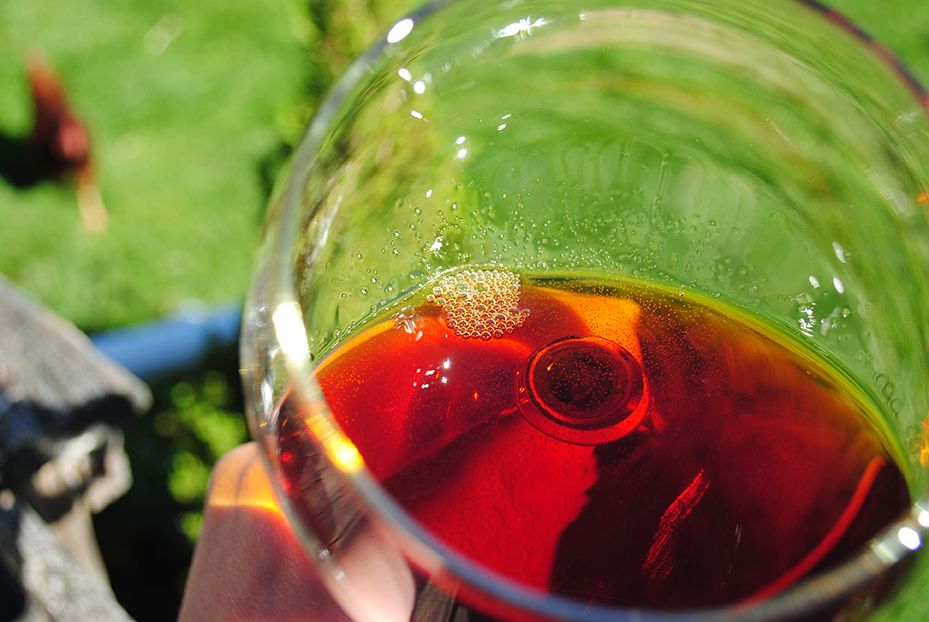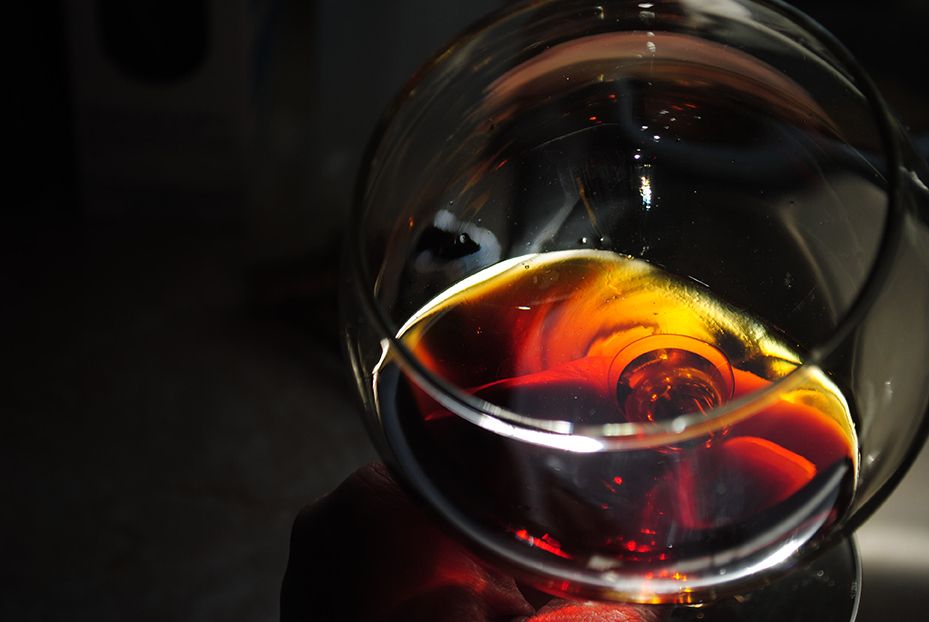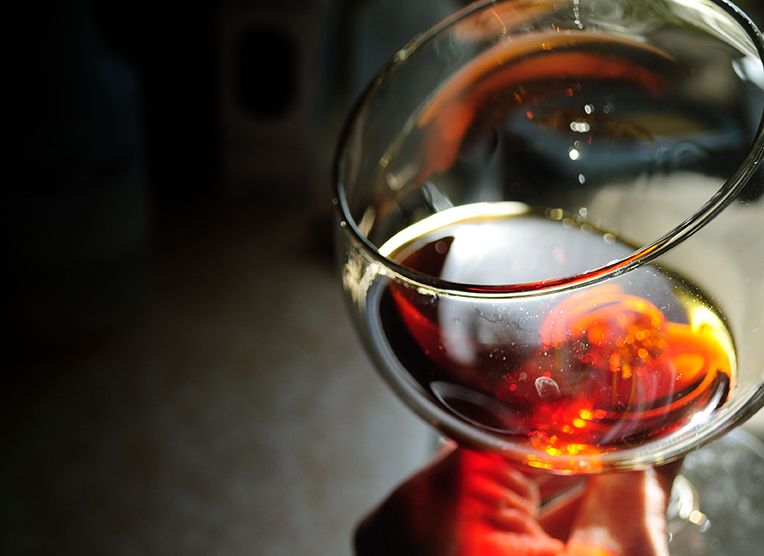Just for reference, here is that recipe in the original French and in English translation (from Eileen Power's 1928 The Goodman of Paris:
Le Menagier de Paris
A "sester" seems to be, in English measure, 15 pundas, or 12 or so pounds, making is about 1.5 gallons. But the original French sextier can refer to different measures sizes, this one is most likely eight pints or a gallon. Ish.
So you've either got about 1-1/2 gallons of honey per 9 gallons of water, or 1-1/2 per 6, depending. I'm guessing it was most likely meant to be six. We did 1-1/2 with four of water, decided on new spices/herbs that we thought would harmonize with the decribed "roasted marshmallow" flavor, planned a nutrient schedule and so on.
I also looked at a bunch of other old recipes, too. Looks like some of the old recipes in the famous Digbie book call for cooking the honey and water for about a half hour, probably to sanitize but also to remove the scum. This first one here seems to caramelize the honey when the water has already been added, boiling it for three hours:
The Closet of the Eminently Learned Sir Kenelme Digbie Knight Opened
Here's another one that seems to do some caramelization--not so much as the first. And it has the same ratio of honey to water (1:4) as the French one (depending on how you measure a sester):
I'm given to understand the egg was used as a sort of primitive hydrometer. This seems strange to me, since an egg will even float in water if it's old. But I suppose Digbie was even further from the LHBS than we are. In the above recipe, as much egg should be sticking out of the liquid as a sixpence is wide.
Seems a little ucky. But then again, a lot of old recipes call for clarifying the mead by cooking it with egg white and broken egg shell.
I looked at other recipes, too. Like this one has a sort of nutrient addition.
However, Elf doesn't care for raisins, and in the end it seemed silly to do it this way since we had nutrient on hand anyway.
Most were like this: just boil a half hour or so and then pitch yeast.
So, those are some I looked at. I could swear I found a modern meadery that had posted a description of its bochet, but I can't find it off hand. This one describes bochet as burnt sack, but doesn't carry a bochet (at least not right now). This one has a bochet, but no real description of the recipe. Sorry I can't find the one I was examining at the time. It sounded interesting. It was a burnt sack, too.
Le Menagier de Paris
BOCHET. Pour faire six sextiers de bochet, prenez six pintes de miel bien doulx, et le mettez en une chaudière sur le feu et le faites boulir, et remuez si longuement que il laisse à soy croistre, et que vous véez qu'il gette bouillon aussi comme petites orines qui se creveront, et au crever getteront un petit de fumée aussi come noire: et lors faites-le mouvoir, et lors mettez sept sextiers d'eaue et les faites tant boulir qu'ils revienguent à six sextiers, et tousjours mouvoir. Et lors le mettez en un cuvier pour refroidier jusques à tant qu'il soit ainsi comme tiède; et lors le coulez en un sas, et après le mettez en un tonnel et y mettez une choppine de leveçon de cervoise, car c'est ce qui le fait piquant, (et qui y mettroit levain de pain, autant vauldroit pour saveur, mais la couleur en seroit plus fade,) et couvrez bien et chaudement pour parer. Et se vous le voulez faire très bon, si y mettez une once de gingembre, de poivre long, graine de paradis et cloux de giroffle autant de l'un que de l'autre, excepté des cloux de giroffle dont il y aura le moins, et les mettez en un sachet de toile et gettez dedans. Et quant il y aura esté deux ou trois jours et le bochet sentira assez les espices et il piquera assez, si ostez le sachet et l'espraignez et le mettez en l'autre baril que vous ferez. Et ainsi vous servira bien celle pouldre jusques à trois ou quatre fois.
"BOCHET. To make six sesters of bochet take six pints of very soft honey and set it in a cauldron on the fire, and boil it and stir it for as long as it goes on rising and as long as you see it throwing up liquid in little bubbles which burst and in bursting give off a little blackish steam; and then move it, and put in seven sesters of water and boil them until it is reduced to six sesters, always stirring. And then put it in a tub to cool until it be just warm, and then run it through a sieve, and afterwards put it in a cask and add half a pint of leaven of beer, for it is this which makes it piquant (and if you put in leaven of bread, it is as good for the taste, but the colour will be duller), and cover it warmly and well when you prepare it. And if you would make it very good, add thereto an ounce of ginger, long pepper, grain of Paradise and cloves, as much of the one as of the other, save that there shall be less of the cloves, and put them in a linen bag and cast it therein. And when it hath been therein for two or three days, and the bochet tastes enough of the spices and is sufficiently piquant, take out the bag and squeeze it and put it in the other barrel that you are making. And thus this powder will serve you well two or three times over."
A "sester" seems to be, in English measure, 15 pundas, or 12 or so pounds, making is about 1.5 gallons. But the original French sextier can refer to different measures sizes, this one is most likely eight pints or a gallon. Ish.
So you've either got about 1-1/2 gallons of honey per 9 gallons of water, or 1-1/2 per 6, depending. I'm guessing it was most likely meant to be six. We did 1-1/2 with four of water, decided on new spices/herbs that we thought would harmonize with the decribed "roasted marshmallow" flavor, planned a nutrient schedule and so on.
I also looked at a bunch of other old recipes, too. Looks like some of the old recipes in the famous Digbie book call for cooking the honey and water for about a half hour, probably to sanitize but also to remove the scum. This first one here seems to caramelize the honey when the water has already been added, boiling it for three hours:
The Closet of the Eminently Learned Sir Kenelme Digbie Knight Opened
WEAK HONEY-DRINK
Take nine pints of warm fountain water, and dissolve in it one pint of pure White-honey, by laving it therein, till it be dissolved. Then boil it gently, skimming it all the while, till all the scum be perfectly scummed off; and after that boil it a little longer, peradventure a quarter of an hour. In all it will require two or three hours boiling, so that at last one third part may be consumed. About a quarter of an hour before you cease boiling, and take it from the fire, put to it a little spoonful of cleansed and sliced Ginger; and almost half as much of the thin yellow rinde of Orange, when you are even ready to take it from the fire, so as the Orange boil only one walm in it. Then pour it into a well-glased strong deep great Gally-pot, and let it stand so, till it be almost cold, that it be scarce Luke-warm. Then put to it a little silver-spoonful of pure Ale-yest, and work it together with a Ladle to make it ferment: as soon as it beginneth to do so, cover it close with a fit cover, and put a thick dubbled woollen cloth about it. Cast all things so that this may be done when you are going to bed. Next morning when you rise, you will find the barm gathered all together in the middle; scum it clean off with a silver-spoon and a feather, and bottle up the Liquor, stopping it very close. It will be ready to drink in two or three days; but it will keep well a month or two. It will be from the first very quick and pleasant.
Here's another one that seems to do some caramelization--not so much as the first. And it has the same ratio of honey to water (1:4) as the French one (depending on how you measure a sester):
ANOTHER
Take a quart of honey to a Gallon of water; set the Kettle over the fire, and stir it now and then, that the honey may melt; let it boil an hour; you must boil in it, a Sprig or two of Winter-savory, as much of Sweet-marjoram; put it into tubs ready scalded, till the next day towards evening. Then tun it up into your vessel, let it work for three days; after which hang a bag in the barrel with what quantity of Mace and sliced Nutmeg you please. To make it stronger then this, 'tis but adding more hony, to make it bear an Egg the breadth of a six pence, or something more. You may bottle it out after a month, when you please. This is the way, which is used in Sussex by those who are accounted to make it best.
I'm given to understand the egg was used as a sort of primitive hydrometer. This seems strange to me, since an egg will even float in water if it's old. But I suppose Digbie was even further from the LHBS than we are. In the above recipe, as much egg should be sticking out of the liquid as a sixpence is wide.
Seems a little ucky. But then again, a lot of old recipes call for clarifying the mead by cooking it with egg white and broken egg shell.

I looked at other recipes, too. Like this one has a sort of nutrient addition.
MEATH WITH RAISINS
Put forty Gallons of water into your Caldron, and with a stick take the height of the water, making a notch, where the superficies of the water cometh. Then put to the water ten Gallons of Honey, which dissolve with much Laving it; then presently boil it gently, skimming it all the while, till it be free from scum. Then put into it a thin bag of boulter-cloth containing forty pound weight of the best blew Raisins of the Sun, well picked and washed and wiped dry; and let the bag be so large, that the Raisins may lie at ease and loosly in it. When you perceive that the Raisins are boiled enough to be very soft, that you may strain out all their substance, take out the bag, and strain out all the Liquor by a strong Press. Put it back to the Honey-liquor, and boil all together (having thrown away the husks of the Raisins with the bag) till your Liquor be sunk down to the notch of your stick, which is the sign of due strength. Then let it cool in a woodden vessel, and let it run through a strainer to sever it from the settlings, and put it into a strong vessel, that hath had Sack or Muscadine in it, not filling it to within three fingers breadth of the top (for otherwise it will break the vessel with working) and leave the bung open whiles it worketh, which will be six weeks very strongly, though it be put into a cold cellar. And after nine moneths, you may begin to drink it.
However, Elf doesn't care for raisins, and in the end it seemed silly to do it this way since we had nutrient on hand anyway.
Most were like this: just boil a half hour or so and then pitch yeast.
ANOTHER OF THE SAME LADY [Lady Stuart]
To four Gallons of water put one Gallon of honey; warm the water Luke-warm before you put in your honey; when it is dissolved, set it over the fire, and let it boil half an hour with these Spices grosly beaten and put in a Canvass-bag: namely, half an Ounce of Ginger, two Nutmegs, a few Cloves and a little Mace; and in the boiling put in a quart of cold water to raise the scum, which you must take clean off in the boiling. If you love herbs, put in a little bundle of Rosemary, Bays, Sweet-marjoram and Eglantine. Let it stand till it is cold, then put into it half a pint of Ale-barm, and let it work twelve hours; then Tun it, but take out the bundle of herbs first.
So, those are some I looked at. I could swear I found a modern meadery that had posted a description of its bochet, but I can't find it off hand. This one describes bochet as burnt sack, but doesn't carry a bochet (at least not right now). This one has a bochet, but no real description of the recipe. Sorry I can't find the one I was examining at the time. It sounded interesting. It was a burnt sack, too.















![Craft A Brew - Safale S-04 Dry Yeast - Fermentis - English Ale Dry Yeast - For English and American Ales and Hard Apple Ciders - Ingredients for Home Brewing - Beer Making Supplies - [1 Pack]](https://m.media-amazon.com/images/I/41fVGNh6JfL._SL500_.jpg)













































